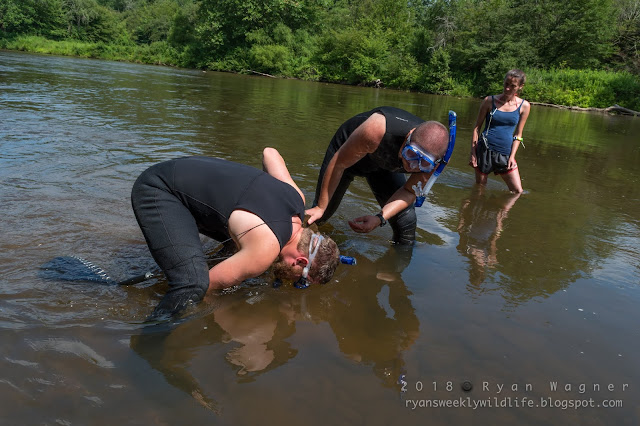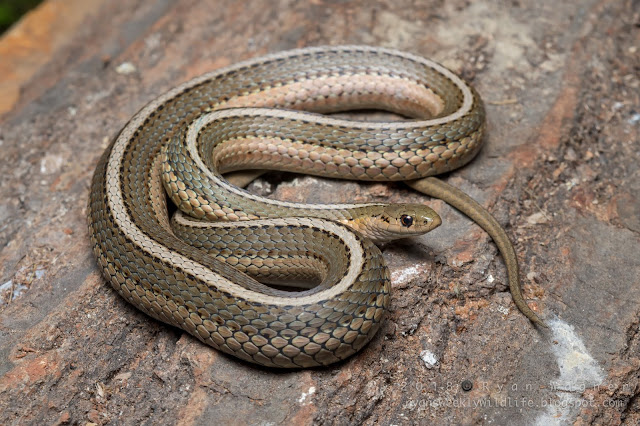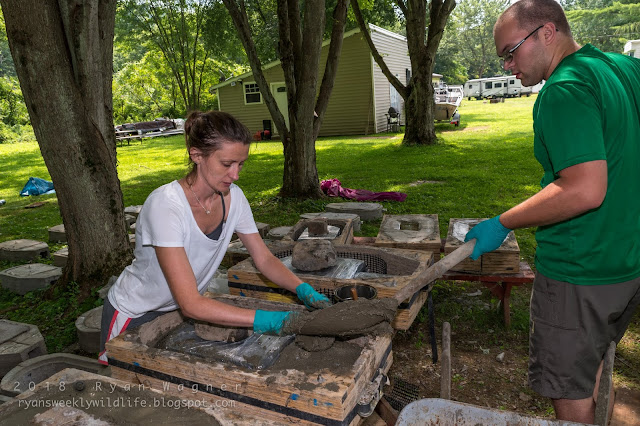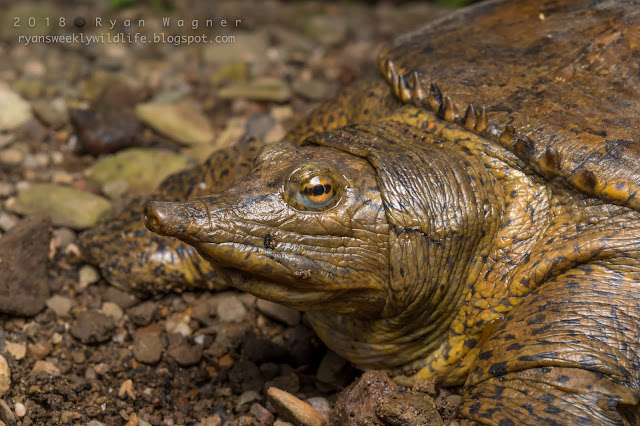Part 1 HERE.
We moved along the stream in transects, attempting to examine every large rock we came across. I felt my feet go numb as I shuffled through the icy water. As we moved past the coldest current, I was relieved to find the main stretch of river pleasantly warm. We had feared the recent rains would muddy the waters and obscure our view of the bottom, but even where the river reached my waist, I could just make out the silhouettes of large stones through the water’s reflective surface. It was a relief to find the stream workable, if not in prime condition.
 |
| Matt and Andrew measuring the width of the stream. |
Donned in full wet suits, Matt and Andrew drifted along on their stomachs, examining the stream bed. Matt busily showed Andrew how to search for suitable rocks where hellbenders might be hiding. The stones had to be large, flattened and provide a tight cavity that lacked a significant current. Christine and I were to record the number of available rocks and whether they could be flipped or not.
“I’m gonna need you guys to help hold this one,” Matt said, indicating a broad, flat rock lying a meter below the surface. Together, we lifted the immense stone slab until it was standing vertically in the water column. Andrew and I gripped its algae-covered surface, straining to keep the current from toppling the stone backwards. If this was a hellbender’s home, we wanted to move it as little as possible. There was a moment of still anticipation as Matt rummaged around in the sediment. His blue snorkel broke the surface with an excited hum. A moment later, he popped up with a shiny, squirming hellbender clutched firmly in his gloved hand. I heard myself let out a cheer of delight. Matt plopped the squirming mass into his net and handed it to me. I looked over the rim at the sleek, brown creature, undulating over itself with liquid fluidity. I reached in and touched its shimmering skin, firm and slippery like Jell-O.
I carefully shuffled along the uneven river bottom back to the shore where we would process the ‘bender. Matt slid the salamander into a halved PVC pipe to make it easier to work with and measure. In this controlled setting, we could admire the full glory of this enormous amphibian. Its body was about a foot and a half long (adults can reach 26 inches) and thick around as my forearm. It was a dark olive, brown with beady, fish-like eyes and wrinkled skin. Hellbenders possess both lungs and gills, but they breath primarily through the wrinkled flaps of skin along their flanks that have earned them the nickname ‘old lasagna sides.’ Other curious names include ‘snot otter’ and ‘devil dog.’ Despite old fisherman's tales, these formidable-looking salamanders are completely harmless.
 |
| Matt Kaunert with an eastern hellbender. |
“In Ohio the populations are pretty bad. Here in Pennsylvania they’re doing better and in some streams the numbers are really very good,” Matt explained. Once found throughout the Ohio River and its tributaries, hellbender populations have decreased by some 82% in Ohio. Siltation—when streams become chocked with sediment from runoff—is largely to blame for the decline. Diseases like chytrid fungus (Bd), habitat loss, acid mine drainage and other pollutants are also lead causes. Combined, these impacts have left the eastern hellbender at risk for extirpation in my home state. Adults not killed by the changes in their environment face another problem effecting the long-term survival of their species: an inability to successfully reproduce.
Hellbenders are long lived animals; they can survive in the wild for over 30 years. Hellbenders don’t begin breeding until they are between five and eight years of age. From August to September, Males defend a territory and excavate a nest. Females may each lay up to 500 eggs and allow a male to externally fertilize them (a rare trait in salamanders). The male then guards the eggs until they hatch, fanning them with his tail to provide oxygen, and even selectively eating bad eggs. When siltation smothers a nest, males are incapable of successfully caring for the eggs and often end up eating the entire batch. The reasons behind this are not fully understood.
In streams where siltation has been reduced, hellbender populations have still not rebounded. Many modified streams lack the large rocks under which hellbenders lay their eggs. That is where Matt’s nest boxes come into play. These artificial rocks will not only provide hellbenders with a place to nest, but also allow us a noninvasive way to monitor their behavior and reproductive success. Determining if hellbenders will use these concrete coffins is the trick. Ohio’s populations are too sparse for a large scale behavioral experiment like this. That’s why PA, with its relatively intact populations, is the starting point for the project. If all goes as planned, these boxes will be used to help boost Ohio’s dwindling hellbender numbers to sustainable levels.
Matt and Andrew flipped some 68 rocks and caught three hellbenders and a mudpuppy (a smaller species of fully aquatic salamander) by the end of our search. The second two ‘benders were smaller, about a foot in length. “That’s a reassuring size,” Matt pointed out. Young, three-year-old hellbenders are clearly surviving in these streams—a sign that populations are still healthy. We were ecstatic to have caught something even when conditions had seemed so poor.
Matt and Andrew flipped some 68 rocks and caught three hellbenders and a mudpuppy (a smaller species of fully aquatic salamander) by the end of our search. The second two ‘benders were smaller, about a foot in length. “That’s a reassuring size,” Matt pointed out. Young, three-year-old hellbenders are clearly surviving in these streams—a sign that populations are still healthy. We were ecstatic to have caught something even when conditions had seemed so poor.
Some streams that Matt surveys have such a dense population that, "every other rock seems to hide a hellbender," he explained. Soon we will return to PA for more hellbender surveys and to deploy Matt's nest boxes. We will also be releasing head-started juveniles in streams in Ohio and West Virginia. It is exciting to be part of the effort to bring back one of Ohio's most impressive amphibians.
More soon and keep living the field life.
RBW

















